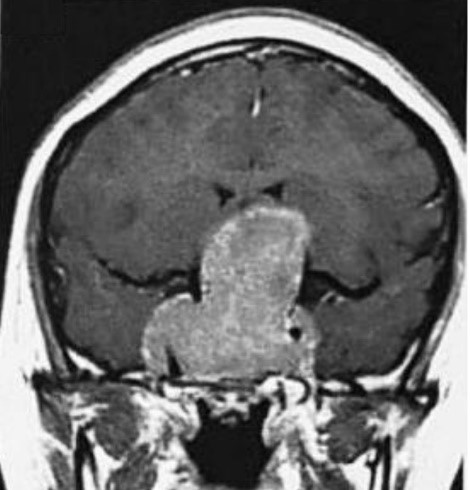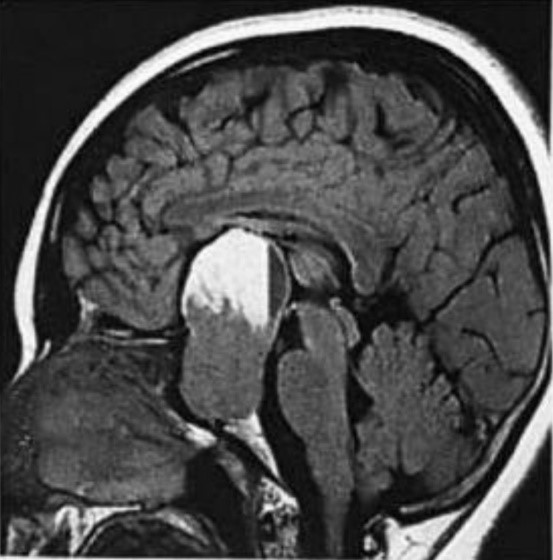Current Research in Psychiatry and Brain Disorders
Case Report
ASeverely Invasive Macro Adenoma of the Pituitary Gland Lead to Visual Failure: A Case Report
Alahmari A*
Department of Anatomy Radiology Specialist, King Saud niversity, Saudi Arabia
*Corresponding author: Abdulwahab Alahmari, Department of Anatomy Radiology Specialist, King Saud niversity, Saudi Arabia, Tel: +966549157485; Email: afaa99@hotmail.co.uk
Citation: Alahmari A (2019) Non-Traumatic Epidural Hemorrhage in a Sickle Cell Anemia Patient: A Rare Case. Curr Res Psychiatry Brain Disord: CRPBD -100004.
Received date: 01 October 2019; Accepted date: 15 October 2019; Published date: 23 October 2019
Abstract
A pituitary gland macroadenoma is a common disease with one type of invasion, but this case of macroadenoma has all three types of invasion which lead to visual failure in both eyes.
Keywords: Eye visual failure; Pituitary gland;Tumor
Case Report
A sixteen-year-old female patient came to the neurology center at King Abdullah Medical City with total left eye visual failureand right eye distorted vision very close to blindness (light can be seen, but the fuzziness causes object cannot be determined) with a 0/20 visual acuity and Goldman perimeter of the visual field test proved a complete visual dysfunction.The patient never felt any symptoms or hormonal imbalance or menstrual issues except experiencing a chronic headache every week. Then, she lost her vision suddenlyin the left eye and in a fast graduallyrhythm in the right eye.One year took the patient before she came to visit to the neurology center. An MRI scan was requested for the patient which revealed a massive tumor in the pituitary gland> 10mm which excluded microadenomas.The dimensions of the tumor are (18.6 cm as width, 17.2 cm as height, and 7.5 cm as length). A time 1(T1) pulse sequence with contrast was preformed which showed all three types of possible invasion:
The blood test came normal for the hormones levels and the biopsy confirmed the case as benign macroadenoma and excluded pituitary gland carcinoma. The macroademnoma was compressing the optic chiasma and nerves causing visual failure. The medical team decided to perform anendoscopic trans-siphenoidal surgery which used 1 cm endoscope entering from the nose to cross the sphenoid bone to the pituitary gland to remove the tumor. All the judgments on the medical imaging study were confirmed during surgery. After eight-hour-long surgery, the patient woke up next day and clinical exams were performed to check her visual ability. The patient can see 20/20 for both eyes after the tumor has been removed. The severity of this case was on the left side which caused the loss of vision suddenly (Figure 1 and Figure 2).
Discussion
Chiasmal dysfunction and visual failureare associated with pituitary macroadenoma [1]. The prevalence of all types of pituitary adenomas is 22.5% in imaging studies [2]. The endoscopic trans-siphenoidal surgery intervention to remove the pituitary macroadenoma can lead to post-operative complication like cerebrospinal fluid (CSF) leakage [3].

Figure 1: (A sixteen-year-old female). A brain MRI scan on the coronal section of T1 with contrast. An invasion in the third ventricle and compressed lateral ventricle, an invasion in the cavernous sinus and the cavernous segment of the left internal carotid artery and compression against the medial aspect of the parietal and temporal lobes.

Figure 2: (A sixteen-year-old female). A brain MRI scan on the sagittal section of T1 with contrast. The sephenoidal invasion and compression of the frontal lobe from the posterior aspect. The tumor extends from the rostrum of the corpus callosum to the sphenoid bone.
Citation: Alahmari A (2019) Non-Traumatic Epidural Hemorrhage in a Sickle Cell Anemia Patient: A Rare Case. Curr Res Psychiatry Brain Disord: CRPBD -100004.